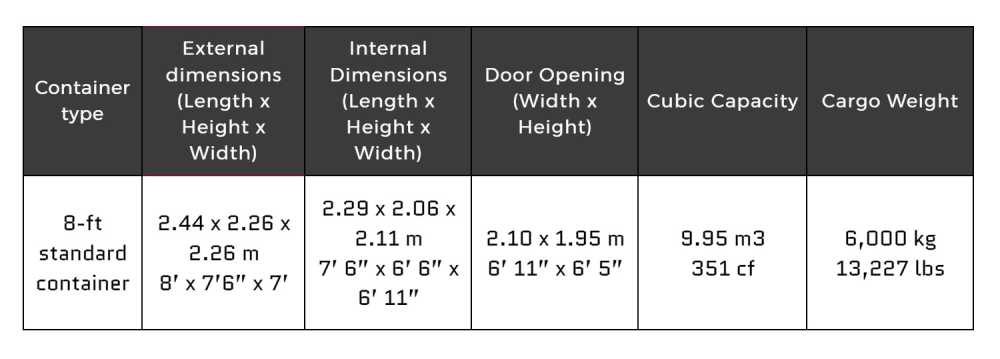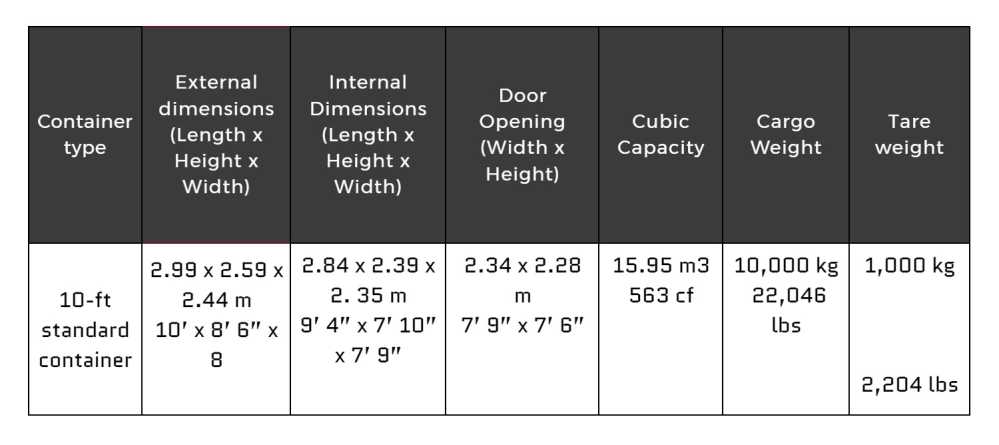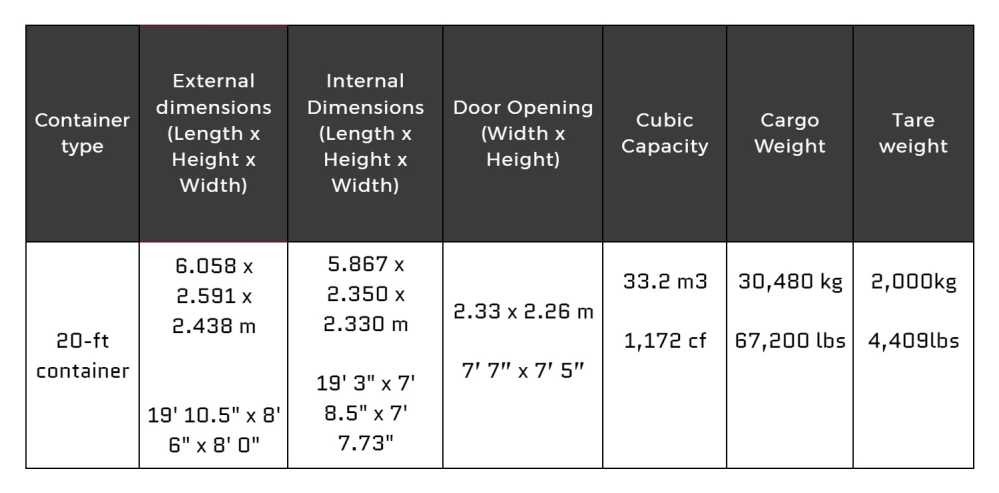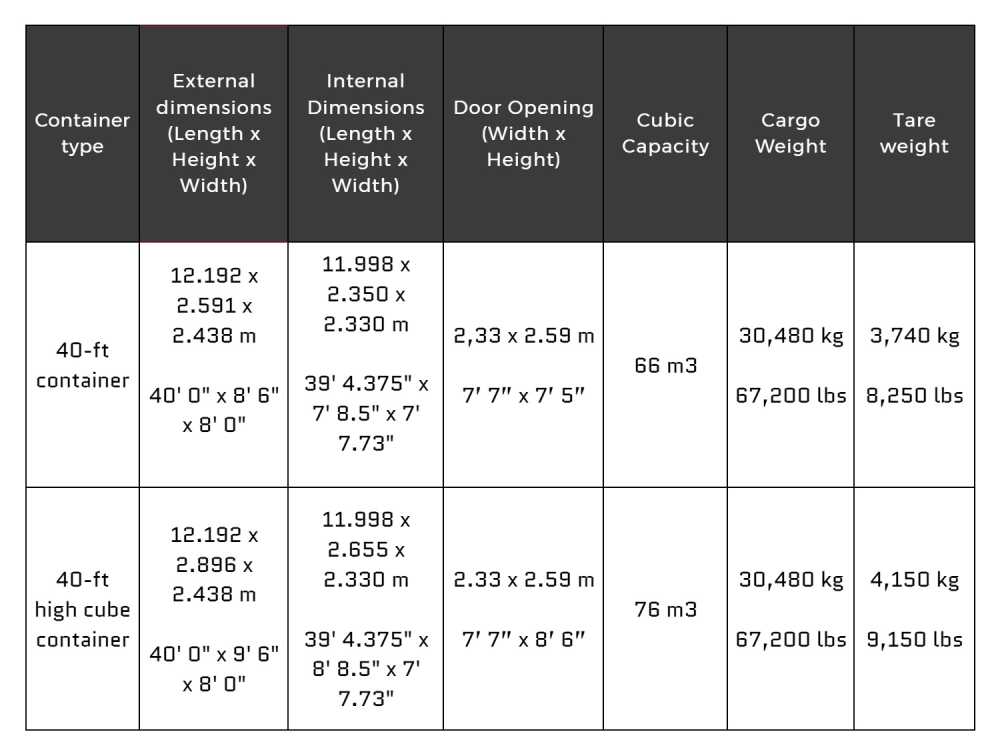
by Sam Franklin | June 02, 2022 | 6 min read
A quick and easy guide to size, dimension, and types of shipping containers
Get fundedLast updated: June 03, 2022
It may seem fairly straightforward, but there are various things to consider when choosing a shipping container for your cargo. You have to consider how many containers you need, whether your products are too tall, oddly-shaped, or if they need refrigeration or a forklift for loading. An important consideration people have is how much cargo can a container hold. The capacity of shipping containers depends on their type, but the most commonly used large containers are typically 12 m × 2.4 m (40 ft x 8 ft) and these can carry a maximum load of approximately 20 tons.
This article will discuss everything you need to know about container dimensions, sizes, and types, to help you move your goods efficiently.
Table of contents
Types of containers
Let’s start with the different types of containers available for shipping cargo across countries and continents, so you can pick the one that best suits your needs:
1. Standard dry shipping containers
These are the most common general-purpose containers that can be used for shipping by rail, road, or water. Standard containers are made for all kinds of dry solid products. They are usually about 8 feet (2.43m) wide, 8.5 feet (2.59m) high, and designed to keep moisture out. Made of aluminium or steel, these usually come in two lengths: 20-ft and 40-ft. Steel containers have a slightly larger internal cube, while aluminium containers have a slightly larger payload (net cargo weight transported) and are generally used for domestic shipping.
2. High cube containers
A high cube container is approximately a foot taller than standard dry containers making it perfect for products that need extra height or space. These are well-suited for short-sea shipping and have the same loading capacity as trailers. High cube variations come in both 20-ft and 40-ft containers.
3. Open-top containers
If your products are very large but not big enough for a high cube unit and need a forklift, open-top shipping containers are for you. They have a removable top to make the loading and unloading process simpler. Open-top doesn’t imply they will be open while being shipped. They will either have a hard, removable steel roof or a soft removable tarpaulin roof.
4. Flexitank containers
These containers are specifically designed for non-hazardous liquid goods like water or cooking oil. The flexitank is essentially a hermetically (airtight) sealed, collapsible bag loaded with product and secured inside the shipping container to avoid movement. A flexitank container is commonly designed to hold 10,000 - 24,000 litres of liquid cargo, but it can be customised to fit up to 100,000 litres of liquid product.
5. Insulated containers
Insulated or thermal containers have regulated temperature control which makes them ideal for long-distance transportation of pharmaceutical products, frozen goods, fresh produce, or chemicals. These products need to be shipped at specific temperatures and protected from contamination. This is why insulated containers are equipped with a mechanical compressor to keep the air inside cool or hot, akin to a thermos flask.
6. Special purpose containers
Manufacturers also customise special containers for customers who want to ship special cargo like weapons. A special container is manufactured with specific material composition to make it safe, secure and suitable for the goods it is designed to carry.
7. Reefer containers
Reefer or refrigerated containers are used for shipments that need temperature control. These are equipped with a refrigeration unit connected to the power supply on a ship. Reefer containers maintain a certain temperature, ventilation, and humidity to efficiently ship temperature-sensitive goods like fruits, meat, vegetables, seafood, or dairy.
Shipping container sizes and dimensions
Here are the standard shipping container dimensions for the 8, 10, 20, and 40 feet units, including external and internal length, width, and height. It is important to consider the internal height and the internal width and length to utilise the space most efficiently.
8-ft standard container dimensions:
These are usually the smallest containers available for shipping; they are roughly the size of an average garden shed.
m = metre; cf = cubic foot; lbs = pound; kg = kilogram; m3= cubic metre

10-ft standard container dimensions
These containers are largely used for shipping overland. A 10 feet container is suitable if you are looking for secure cargo storage in a limited space or want to move your goods on trucks.

20-ft standard container dimensions
A 20-ft container is roughly the size of a car garage. These are easy to stack on vessels, making them relatively cheaper to ship.

40-ft standard container dimensions
Compared to 20 feet containers which are used mostly to ship heavy goods like machinery, 40 feet containers are commonly used for larger amounts of consumer goods like clothing, electronics, cars, or furniture. A high cube 40 feet container is used for over-height goods; these can be up to 2.7 metres or 8.1 feet tall.

FAQs
How many pallets can you fit in a 40-ft container?
A 40-ft container can fit 20-24 pallets depending on the type of shipment and size. There are slightly different sizes of pallets available, which you need to consider to make the best possible use of space. Here are the sizes recognised by the International Organisation for Standardisation (ISO), and how many a 40-ft container can fit:
Standard/EUR2/ISO2
This is commonly used across Europe and Asia.
Size (Width x Length): 1,200 x 1,000 mm (47.24 x 39.37in)
Number of pallets: 20-21
North American Standard/GMA:
This is commonly used in the U.S. and Canada.
Size (Width x Length): 1,016 x 1,219 mm (40 x 48in)
Number of pallets: 20
EUR/EUR1/ISO1
This pallet size is also used in Europe.
Size (Width x Length): 800 x 1,200 mm (31.5 x 47.24")
Number of pallets: 23-24
How many pallets can fit in a 20-ft container?
Here are the number of pallets that can fit into a 20-ft container based on size:
Standard/EUR2/ISO2
Size (Width x Length): 1,200 x 1,000 mm (47.24 x 39.37")
Number of pallets: 10
North American Standard/GMA
Size (Width x Length): 1,016 x 1,219 mm (40 x 48")
Number of pallets: 10
EUR/EUR1/ISO1
Size (Width x Length): 800 x 1,200 mm (31.5 x 47.24")
Number of pallets: 11
How big are shipping containers?
Shipping and storage containers come in a variety of sizes. The most common ones are 20-ft and 40-ft in length and 8 feet in width. In terms of height, containers are commonly 8 feet and 6 inches. High cubes are slightly taller at 9 feet and 6 inches.
How tall are shipping containers?
Most commonly used containers are 8 feet and 6 inches, and high cubes are about a foot taller at 9 feet and 6 inches.
Written by

Sam founded his first startup back in 2010 and has since been building startups in the Content Marketing, SEO, eCommerce and SaaS verticals. Sam is a generalist with deep knowledge of lead generation and scaling acquisition and sales.


